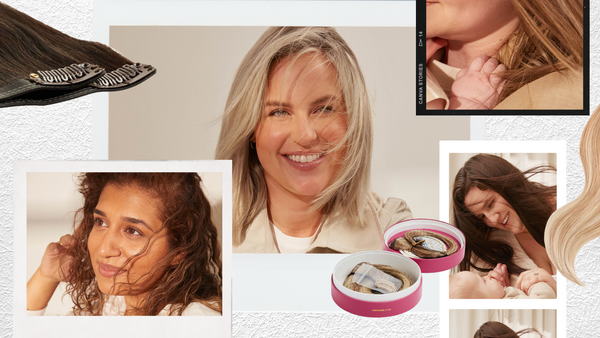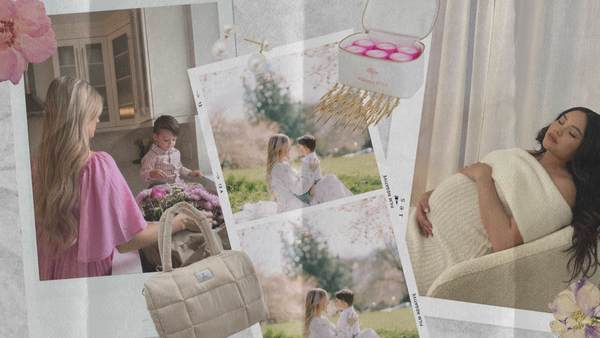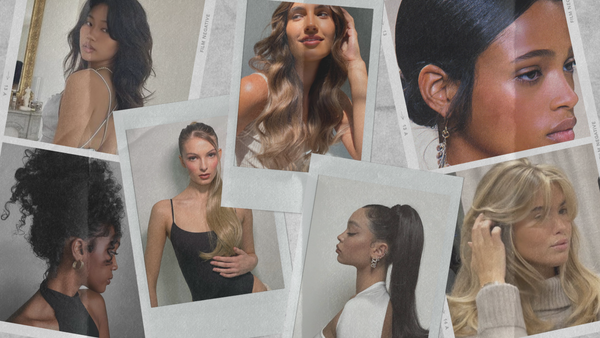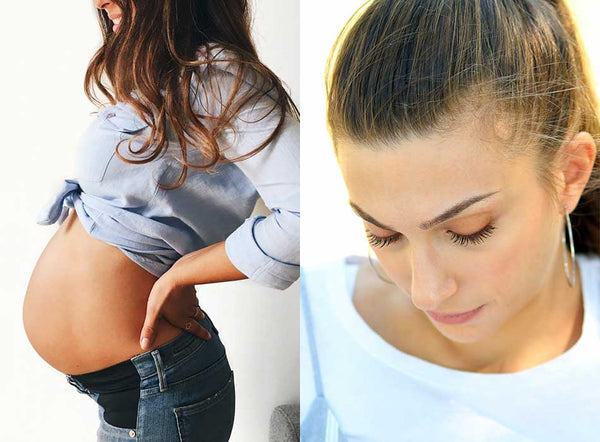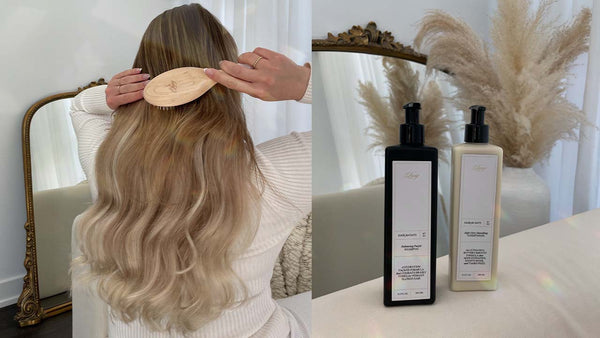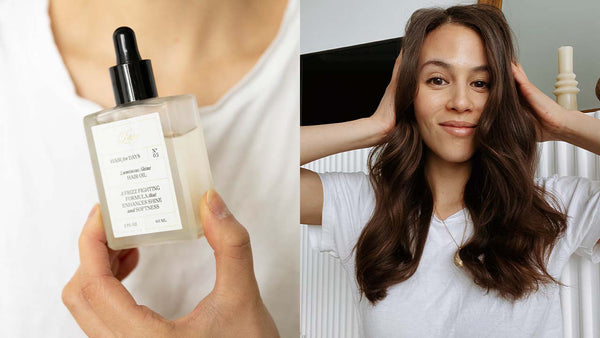Our mission at Luxy Hair is to help women look and feel their best. That means providing everyone with the resources they need to achieve their best, healthiest hair ever. Whether it’s finding the perfect set of hair extensions or learning how to care for your tresses, we are here to share everything you need to know to maintain a gorgeous, healthy head of hair.
It’s no secret that dying your hair causes damage. From wild colors to simply covering greys, and everything in between, hair dye is one of the most common and widely used products whether you’re getting pampered at the salon or doing it yourself at home.
To keep you in the know, here’s everything you need to know on how to naturally dye your hair as well as the effects of using chemical hair dye.
Full disclosure, although dyeing your hair naturally is certainly possible, there is still a science behind dyeing your hair. Be sure to consult with a hair colorist before dyeing your hair so that you can be sure to achieve the results you're looking for. Many hairstylists and colorists are now offering virtual consultations while businesses are shut down, and many are more than happy to provide a consultation for a nominal fee.

Why you should avoid chemical hair dyes
It’s important to note that although prolonged use of chemical hair dyes can take a toll on the condition of your hair, they are not hazardous to your overall health. Still, we think it’s important that you understand how chemical dyes can impact your hair and scalp and are well-versed on how to care for hair that’s chemically dyed, while being aware of other options if you prefer a natural method of dying or lightening your hair.
So, what are the negative effects of dying hair? Well, to understand how the dying process works, you need to know the anatomy of your hair. Don't worry, we promise not to bore you with a lengthy lecture.

Let’s start with the hair itself. Each strand of hair is protected by the cuticle, which is basically overlapping cells on the outside of each hair strand, similar to the way fish scales are positioned. Whether you’re bleaching your hair or dying it, both processes affect the condition of the cuticle. To change the color of your hair (especially if you want a lighter shade) you need to make room for pigment, this means removing the color that is currently there. In order for the color to penetrate the hair, the cuticle must be lifted via a chemical process to make it possible for the dye to permanently stay.
While bleaching your hair strips it of its natural oils. Both of these processes alter the state of your hair cuticle. Virgin hair, AKA hair that has not been dyed or gone through a chemical process has a cuticle that lays flat; unprocessed hair possesses a natural shine that is silky-smooth and elastic. While prolonged use of chemical dyes do a number on cuticles, causing your natural shine to dull creating a rough, dehydrated, and less elastic texture. For hair that’s been overly processed and is desperate for a surge of moisture check out these DIY hair masks!).
What are the benefits of natural hair dye?
Less harsh on hair
Decreasing the amount of chemicals that come into contact with your head is always better for your hair. Natural dyes don’t penetrate the hair cuticle as intensely as chemical dyes would so they won’t leave your hair brittle, frizzy, and dehydrated.
Won’t strip away your natural oils
Unlike bleach and other chemical dyes, natural dyes won’t strip away your natural oils as much or leave your hair as dry. It’s important to remember that the oil your body naturally produces is what helps keep you hair and scalp soft, healthy, and hydrated. That’s why undyed hair has that coveted, silky-smooth sheen.
Safer for your body
Whatever you apply on your skin is absorbed into your body. When hair dye comes into contact with your scalp, it is also being absorbed so it's important to be mindful about what products we apply and what ingredients they contain.
Nourishing for your hair
Natural henna and honey can be incredibly nourishing for you hair and scalp. They can be used as a natural deep conditioning mask that doubles as a natural dye. It is also great for soothing the scalp and combating dandruff. They’re multi-tasking hair products that are totally au-natural!
Less expensive
Using natural dyes is a total money saver! Instead of heading to the salon every 3-4 weeks, you can do at home treatments. Most ingredients used in natural dyes can be found right in your kitchen or the local grocery store. Saving trips to the salon for a do-it-yourself at home treatment will help you save big bucks- especially if you’re someone who frequents the salon for regular touch ups and maintenance.
Do natural hair dyes have any side effects?
Unlike chemical dyes, natural methods of dying hair are significantly safer than what you would get at the salon or local beauty store. Just be sure to double check that you are not allergic to any of the ingredients. Everyone’s body is unique and can react differently to certain products; even natural ingredients have the potential to irritate the skin. Whatever you plan on using for your natural dye, whether it’s natural henna, beet juice, or honey…always do a test patch the night before on your body to see how your skin will react.

One of the most common side effects of using dyes, whether it’s boxed dye or made from food, is that they can leave unwanted stains on your skin. Even though you are using natural dyes you absolutely still need to wear gloves to avoid staining your hands for several days—possibly even longer! If the dye gets on your ears, face, or neck (which it often does) you can use lemon juice as a simple, convenient, and of course natural way to help lift the stain by slicing a lemon and rubbing it directly on your skin. For a more diluted stain removal method, you can mix the juice of half a lemon with half a cup of warm water and use a washcloth, or simply soak your hands in this mixture if your fingers come into contact with any dye.
Another stain removal method that doesn’t involve synthetic chemicals is olive oil mixed with salt or sugar. Mix the two ingredients together and use it to exfoliate the area you need to remove the dye.

Natural dyes are unique and can be a little tricky if you haven’t used them on your hair before because there isn’t as much variety available. With chemical dyes, on the other hand, you have a wide range of colors to choose from that helps you achieve whichever specific look you’re going for but when it comes to whipping up a natural mixture at home, you can never be 100% certain of how your hair will turn out. A great tip to remember is to test a section of hair with the natural dye that you’re using. We say go for a small chunk of hair that’s a the nape of your neck or underneath a layer of hair so it’s less noticeable. Rinse out the mixture and let you hair dry so you can really see if you love the color or not. Experiment with different mixtures and the length of time you leave it in your hair until you find a color that’s just right for you!

At home tips for dyeing and naturally lightening hair
How to dye hair with henna
Henna is great if you want to darken your hair or add a reddish tinge to it. This natural plant based product has been used for centuries on both skin and hair. Its soothing properties make it great for both the scalp (combating dandruff) and keeping hair shiny. Natural henna can be found at both health food stores and online, but be sure to choose henna that’s totally natural since synthetic chemicals can sneak in there depending on the brand. Henna is available in several shades and usually comes in a powdered form that must be mixed with water to create a creamy paste, though some can come pre-mixed.
Leave the henna in your hair for 1 to 2 hours depending on how intense you want your color to be, then rinse thoroughly. The color will continue to develop even after you wash the henna out, which is why we strongly recommend doing a test patch on your hair 24 to 48 hours before you do your whole head.
Tip: If you do decide to dye your hair with henna, be sure that this is the color you would like to stick with, as henna can be quite difficult to remove. Due to its metallic properties, it cannot be removed with bleach, and therefore will need to grow out on its own.
How to lighten hair with lemon juice and Honey
This simple, two ingredient concoction is the perfect way to change your hair color if you’re looking to go lighter. Both honey and lemon juice contain properties to naturally lighten hair, while honey has antibacterial properties for your scalp and helps strengthen hair. Mix the juice of a whole lemon with 1 tablespoon of honey (feel free to add more of each depending on how long or thick your hair is). Let the mixture sit in your hair for up to one hour or leave it in overnight with your hair wrapped in a towel for more intense results. Rinse thoroughly.
Tip: It is important to note, if your hair is a medium blonde or darker, you may find yourself with an undesired warmth that may need to be corrected. Because it is the acid in lemons that lightens the hair, it exposes the underlying pigment of the hair, which is always a warm tone. This underlying pigment can range from pale yellow (light blondes), golden tones (dark blondes), orange (browns) or red (blacks). This is why it is extremely important to consult with a colorist before giving this DIY hair lightener a try.

Veggie Juice
Brightly colored veggies have long been used to dye clothes and hair. Next time you’re at the grocery store, pick a vegetable with a color that closely resembles the color you’d like to dye your hair. Beets for example leave a great reddish hue on hair while carrots leave a more understated orange color. The best way is to juice a vegetable yourself or order a pressed juice if you don’t own a juicer. It’s a good idea to do this next step in the shower as it can get very messy. Drench your hair in the juice and wait up to 1 or 2 hours for the color to stay.
Hair extensions for added color
A super easy and non-permanent way to instantly add color to your hair without having to deal with dye is using clip in hair extensions. Use a lighter shade to add some brightness to your look or darker extensions for warmth. You can even add balayage or highlights instantly with no trip to the salon. This Luxy blog post will give you a step-by-step tutorial on how to blend the extensions with you own hair for a seamless, natural look (also how to blend extensions if your hair is curly).

Coffee
And last but not least everyone’s favorite morning beverage. A nice way to add warmth and depth to your hair without going too dark is a simple cup of joe. Simply brew a cup, wait for it to cool down, and add it to your hair. Let it sit for at least an hour, then rinse! The longer you wait the darker it will make your hair.
As always when it comes to styling your hair, especially with DIY methods, it’s always best to consult with an expert before taking the plunge. Experiment with methods that are less permanent first, and if you're happy with the results, give more permanent natural dyes a try. If you're looking for a change without altering your hair, simply invest in a set of coloured hair extensions to satisfy your urge for change.
Written By: Nadia Matar

